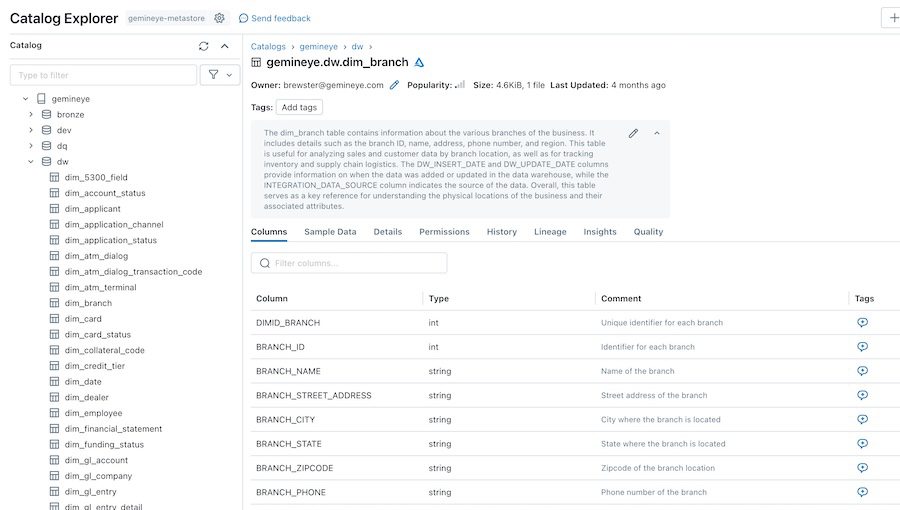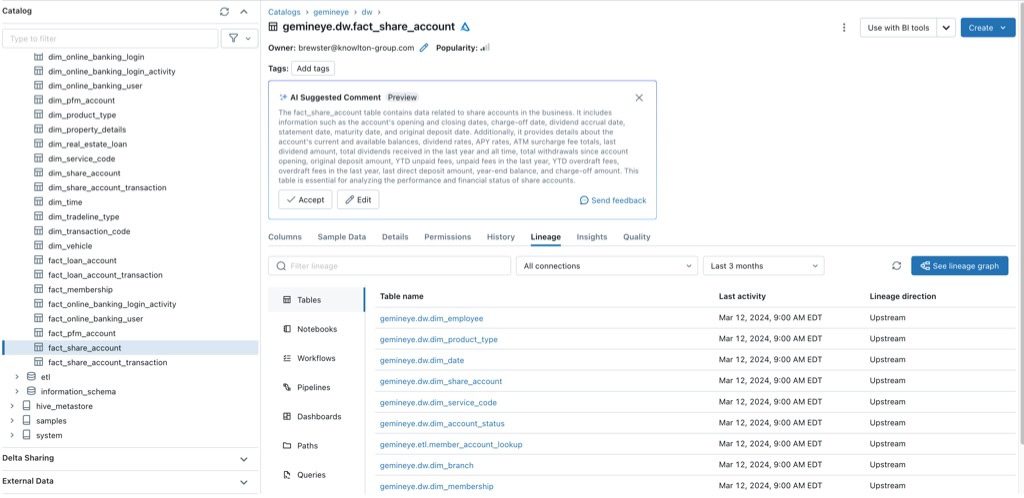Advanced insights out of the box
With over 250 visualizations available out of the box, day one of Gemineye gives your team – technical and non-technical alike – an immense number of reports and dashboards to consume.

It seems we can't find what you're looking for.
We currently support over 75 integrations – even the ones that other data analytics providers won’t touch. Our integrations incorporate leading credit union and bank solutions, like consumer loan and mortgage originations, digital banking, CRM / MRM, third-party data vendors, and more.








Embracing excellence in data analytics and visualizations, our partnership with Gemineye has been a catalyst for innovation. Their solutions empower us to transform raw data into actionable insights, driving strategic decision-making and fostering a culture of success.






We currently support over 75 integrations – even the ones that other data analytics providers won’t touch. Our integrations incorporate leading credit union and bank solutions, like consumer loan and mortgage originations, digital banking, CRM / MRM, third-party data vendors, and more.

Why Data Analytics Matters Data analytics is essential for staying competitive in today’s competitive landscape. A recent study by Jack Henry found that 42% of credit unions prioritize leveraging data ...
Welcome to our very first edition of “A Day in the Life of a Data Analyst,” featuring the equally talented and down-to-earth Ann Ditlow, Data Analyst at 4Front CU. Ann ...
Bill has a deep background in the credit union industry. Throughout his robust career in the industry, Bill has utilized technology and data with finance/accounting to help credit unions and banks ...


Sandwich, Mass (November 17th, 2025) – With $335 million in assets and four branches across Middle Tennessee, US Community Credit Union (USCCU) is investing in a modern data lake to strengthen its analytics foundation and support long-term growth – and they’ve chosen Gemineye as their partner. The partnership between USCCU and Gemineye, who exclusively serves credit unions and community banks, will enable the credit union with a modern data lake platform that unifies data across the organization—improving accuracy, efficiency, and insight while laying the groundwork for predictive analytics and future AI capabilities. As a credit union deeply rooted in the Nashville community, USCCU continues to embrace innovation to better serve its members and empower employees with better tools. “We’ve accomplished a lot with our Power BI environment, but much of our data still lives in manual processes, which isn’t scalable as we grow – it’s time to evolve,” says Kameran Laux, Chief Financial Officer at USCCU (pictured). Gemineye’s world-class Microsoft Power BI and Databricks architecture makes them a compelling choice for nimble, growing financial institutions who want to control their data journey and not be boxed into a rigid solution. “USCCU’s situation is not unusual among our clients,” says Maggie Chopp, Director of Business Development at Gemineye. “Many clients begin working with us after they already have a team of experts and data analytics program in place, but are ready to take it to the next level.” The breadth of experience the USCCU team brings is proof that you can never be too far along in your data journey to improve. USCCU’s data transformation reflects its ongoing commitment to thoughtful innovation, empowering employees with better tools, and creating meaningful impact for members and the communities it serves. Laux explains, “Moving to a modern data lake will automate how we bring data together and strengthen our governance and strategy. Data tells a story, and we’re listening – because the more clearly we understand our members, the better we can serve them.” About US Community Credit Union US Community Credit Union (USCCU) is a $335M, four-branch credit union located in Middle Tennessee, serving the Antioch, Mt. Juliet, and Nashville areas. They are dedicated to improving their members’ lives and making their community better. For more information on USCCU, visit usccu.org. See Gemineye’s Data Lakehouse in Action Interested in learning how the Gemineye Data Lakehouse can support your member and community needs like USCCU? Schedule a personalized discovery call to see how our platform can transform how your institution’s data program.
Sandwich, Mass (October 28th, 2025) – Credit union and community bank data analytics provider Gemineye is excited to announce its partnership with Gesa Credit Union, a $6.4B financial institution and one of Washington state’s largest credit unions. With 45 branches across the Pacific Northwest, Gemineye’s newest client prioritizes the members and communities they serve while expanding their footprint, winning Newsweek’s Best Regional Banks & Credit Unions Award two years in a row. Gesa Credit Union is committed to making a positive impact in the communities we serve and helping our members build strong foundations for their financial journeys and lives they envision. That’s why we partner with organizations that share our values and help us deliver smarter, member-focused solutions,” says Tony Beal, Vice President of Business Intelligence at Gesa Credit Union (pictured). Gemineye’s world-class, Fortune 50 Databricks and Microsoft architecture and flexible platform made Gemineye’s solution the clear choice for an organization focused on growth, quality, and doing what‘s right for their members and communities. “The partnership reflects Gesa’s belief that the right knowledge—backed by the right tools—creates opportunity. Gemineye’s intuitive platform and client-first approach empower our teams to make data-informed decisions that ultimately benefit our members,” explains Beal. “Better technology means more ways to support the communities we call home.” “As an institution that’s growing rapidly, they’ve prioritized data management as a must-have for their continued success,” says Maggie Chopp, Director of Business Development at Gemineye. “We’re excited to provide the foundation on which their data program will develop and immediately drive value and tangible impact for their business teams. We look forward to a successful partnership with the data and leadership team at Gesa!” About Gesa Credit Union Gesa Credit Union is one of Washington’s largest credit unions, with $6.4 billion in assets, and is more than 305,000 members strong. Gesa is a full-service financial institution that offers a complete array of consumer, mortgage, and business products and services. Headquartered in Richland, Washington, Gesa operates 45 branches, loan centers, full-service student-operated campus branches at Washington State University, and 18 student-operated high school branches across Washington state. The Gesa Community Foundation, established in 2022, further supports Gesa’s ongoing commitment to local communities and charitable giving, which includes support for schools, Local Heroes groups, and community organizations through its Affinity Debit Card Program, as well as through its annual youth scholarships, and free financial and educational resources available to members and the general public. For more information, visit gesa.com. See Gemineye’s Data Lakehouse in Action Interested in learning how the Gemineye Data Lakehouse can support your member and community needs like Gesa CU? Schedule a personalized discovery call to see how our platform can transform how your institution’s data program.
When it comes to choosing a data analytics solution for your financial institution, the ability to provide flexible and robust integration options should sit at the top of the list. Why? Because data ingestion is the backbone of a successful data analytics program. Integrations provide the data, and when a data analytics platform doesn’t allow – or makes certain critical integrations very difficult – the entire data foundation can collapse like a domino effect. Here at Gemineye, we’ve heard of countless situations where clients and colleagues have been subject to restrictive integration parameters from data analytics providers, including: 1. Flat out inability to perform certain integrations 2. Charging hefty fees for “custom” integrations or integrations not in their wheelhouse 3. Long wait times or delays to implement an integration request In this article, we’ll break down the basics of integrations and provide tips to protect your financial institution. Let’s dive in. Why Integrations are so Important in a Data Platform There are hundreds of vendors that credit unions and community banks use to run their financial institution, and each one plays a critical role in data ingestion. Of course, the heavy hitters include your core, consumer loan and mortgage originations, and digital banking. But as technology becomes more advanced and nuanced, the third-party vendor and custom integration landscape becomes more dense. That, in turn, provides more choices – and more risk for data analytics provides to not accept that your third-party vendor integrations. For example, some data analytics providers have pre-built integrations for Hubspot, but not InMoment. If your financial institution uses InMoment, then you are stuck with the unpleasant decision of either not incorporating this key data into your platform, or switching over your entire CRM. One can quickly see how frustrating and time-consuming this situation can become. The Wild, Inefficient World of Integrations Many of the leading data analytics platforms today are capable of incorporating most integrations into your existing tech stack. The trouble is that: 1. It’s not easy – integrating one single component into a data warehouse that “doesn’t play nice,” is one of the biggest headache situations we hear from data analysts and CTOs. 2. It’s not cheap – to create a custom integration, the price tag can often stretch into six-figures. We’ve heard this many times. 3. It’s not fast – does 1 to 2 years sound acceptable to you? Not us, either. But this is a realistic timeline for the vast majority of data analytics providers. Custom integrations are often out of the question for credit unions and community banks. Your standard data analytics provider is often doing their integrations piecemeal – one at a time, and at a snail’s pace. It may even take an entire team several months to get through making a small change. It’s also not cheap. Some of these companies will charge a significant price tag for just a single change, and any further changes mean a longer waiting period and a higher price tag, often in the realm of six figures. Every data analyst has a horror story to tell about integrations. Trying to fit processes together that are incompatible is extremely inefficient, and in it can be outrageously expensive to boot. In our world of data management, we’ve found that clients are looking to make things that would otherwise be incompatible fit together on a regular basis, because they have no other choice. They’re often trying to create integrations in platforms that simply aren’t built for them, and they’re trying just about everything to make that square peg fit into that round hole (Excel sheets, anyone?) Questions to Ask Before You Choose a Data Analytics Vendor What data sources are the most important for us to have available? What vendors/systems do we consistently struggle to get data from? Have your potential vendors shown competence in the variety of sources they’ve ingested? (Look for 20+ integrations) Can the vendors provide references or case studies regarding their integration successes? How transparent are they about pricing, change orders, and additional fees? Discover More About the Capabilities of the Gemineye Data Lakehouse The Gemineye Data Lakehouse currently supports over 75 integrations – even the ones that other data analytics providers won’t touch. Our integrations incorporate leading credit union and bank solutions, like consumer loan and mortgage originations, digital banking, CRM / MRM, third-party data vendors, and more. We’ve worked hard to develop a robust suite of integrations that are pre-built, meaning less redundant work for your internal team, less implementation time, and a lot more cost-savings.
We offer complimentary consultations – never pushy, always honest.